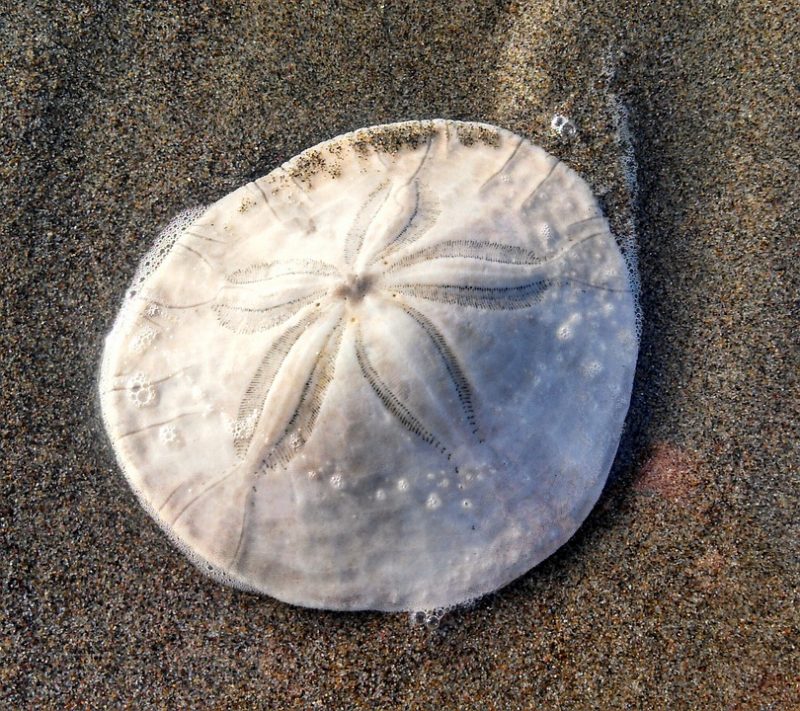
The term sand dollar refers to several species of flattened burrowing sea urchins that belong to the order Clypeasteroida. Sand dollars, also sometimes called sea biscuits or sea cookies, are closely related to urchins, sea cucumbers, and starfish.
They are found in temperate zones virtually all over the world, beneath the mud and sand in bodies of water. Sand dollars first emerged evolutionarily approximately 60 million years ago, at the beginning of the Paleocene era.
They are a common sight at pretty much any beach and are most easily found on the shore after the high tide has gone out.
The term sand dollar comes from the appearance of dead individuals that wash up on shore. The sun-bleached skeleton and the 5-facet floral-esque pattern on top give the appearance of a large silver coin. Folklore myths have identified sand dollars as coins lost by mermaids of the people of Atlantis. Christian groups through history have likened the 5-point pattern to the Bethlehem star, the crucifixion wounds of Jesus, or to an Easter lily.
Anatomy/Physiology Of A Sand Dollar
Sand dollars, like other species in the order Clypeasteroida, possess a rigid skeleton called a test, made of calcium carbonate plates arranged in a radially symmetric manner. Most species fall within 2-4 inches in diameter. Although washed up sand dollar skeletons have been bleached white by the sun, living sand dollars are actually a purplish-brown color. Covering the skeleton is a skin of velvety-textured spines covered in tiny hairs called cilia. Movement of the spines allows the sand dollar to crawl along the seabed floor. Because these spines are so small, it takes quite a while for a sand dollar to move from one place to another. These spines and cilia are also used to eat, as the coordinated movement of spines and hairs move food into the sand dollar’s mouth. Like a starfish, its mouth is located in the center directly under the creatures. This region is sometimes referred to as Aristotle’s lantern, as Aristotle was one of the first to give a systematic biological description of sand dollars.
The petal-like pattern on top of sand dollars is actually a series of pores used for gas exchange and movement. Water flowing in and out of the pores replenishes oxygen stores, and the vascular pressure allows the sand dollar to propel itself in water. The pores can even sometimes take in some sand to act as a weight, to hold the sand dollar in place when it does not want to move. Their flat shape allows them to burrow under sand and other tight places, like under rocks or in between reefs.
Lifestyle/Behavior Of A Sand Dollar
Sand dollars spend most of their time on the ocean floor, slowly creeping along looking for food to eat. Their diet consists mostly of crustacean larvae on the seabed floor, copepods, algae, and dead organic matter. Their spines will carry food to their mouths where 5 jaw-like structures grind the food up. They live close together in a crowded space; a single square yard of seafloor can contain almost 600 individual sand dollars! Since they are composed mostly out of a hard skeleton, they have few predators and are mostly left alone by other creatures. Only a handful of species, such as California sheepheads, ocean pouts, and flounders, regularly feed on sand dollars.
During reproduction, females will release their gamete into the nearby water to be externally fertilized by a male. One fertilized, sand dollar larvae live in the layer of water just above the seabed and go through multiple stages of development before developing a skeleton and settling on the ocean floor. It has recently been discovered that sand dollars in the larval stages are capable of cloning themselves as a mechanism of self-defense. This form of asexual reproduction increases the potential number of viable offspring and serves as a mechanism of self-defense. When sand dollar larvae sense predators nearby, they will clone themselves into multiple copies, doubling their numbers while halving their size. The increased number can confused predators and smaller larva are better at hiding.
On average, sand dollars in their natural habitat live for about 10 years. One can actually tell the age of a sand dollar by counting the rings on the bottom of its body. Once they die, their body will sometimes wash ashore. The heat from the sun evaporates their skin and insides, leaving behind only the main skeleton and other pieces of boney material. Over time, the sun bleaches the skeleton white, resulting in the characteristic pieces that beachgoers frequently encounter.
Collecting Sand Dollars
Since they are so unique looking, sand dollar skeletons make popular collector pieces. There are some rules of thumb to collecting sand dollars though: First, NEVER collect live specimens. Forgoing the fact that capturing live sand dollars is illegal in many beaches in the U.S., live sand dollars are necessary for a thriving ecosystem. Sand dollars remove dead animal material from bodies of water and keep algae populations in check. Removing live specimens can upset that balance. You can tell is a specimen is alive if, when holding it, you can feel the movement of its spines, or it leaves a yellowish residue on your hand. If you find one that is living, simply place it back on the ground in the water.
Sand dollar skeletons, on the other hand, are generally fine to find and keep. Be careful pulling them off of the sand, as the test is rather brittle and can break like a piece of chalk if handled too roughly. Submerging the sand dollar skeleton in a mixture of water and a bit of bleach will clean any residue off the outside and make the white color vibrant. Once the skeleton is dry, apply a mixture of water and white glue to each side to make a protective coating. Alternatively, one can use acrylic varnish or shellac to keep the skeletons from chipping.









